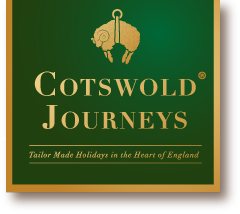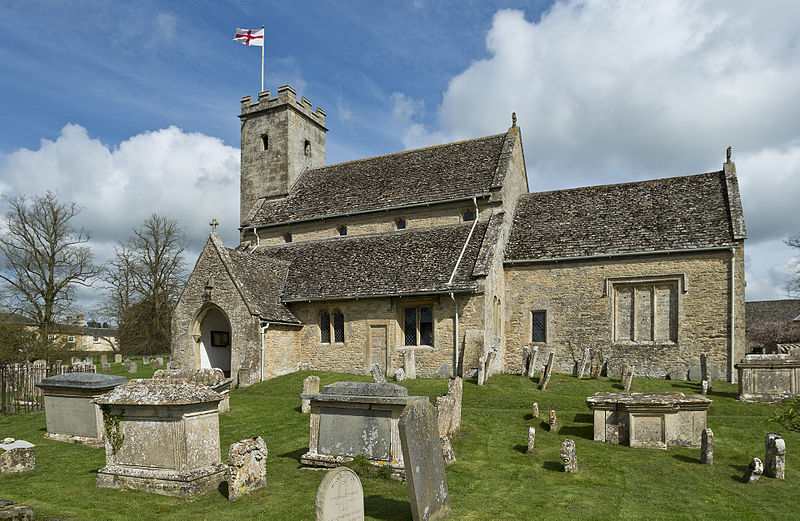Widford
Whatever you do, you will have to walk to the little church of St. Oswald’s at Widford, as it sits alone in a meadow where crop marks show the outline of former village buildings. This, along with the nearby 16th-century manor house, is all that remains of the medieval village, which took its name from the Old English ‘withig for’, ‘the ford by the willows’. Perhaps the village grew out of a Roman villa, the remains of which lie beneath the church. A small area of Roman mosaic was visible in its chancel, but has been moved to Cirencester museum.
The Domesday book records that by 1086 St. Oswald’s Priory in Gloucester held the manor of Widford and did so until the Dissolution of the Monasteries in about 1545, after which the patronage was sold to the Harman family and the land subsequently to the Fettiplace family, whose striking tombs are in Swinbrook Church. It has been surmised that the church owes its existence to a pause here in the transportation of the body of St. Oswald, King of Northumbria, to its burial place in Gloucester. There is some uncertainty about the date of the village’s demise but, as with so many other vanished settlements, it is usually ascribed to the effects of the Black Death, the plague that killed millions across Europe in the 14th century. ‘… But at length, it came to Gloucester, yea even to Oxford and to London, and finally, it spread over all England and so wasted the people that scarce the tenth person of any sort was left alive.’(Geoffrey the Baker, Chronicon Angliae. Also known as Walter of Swinbroke, he was probably a secular clerk at Swinbrook). That plague was devastating. In the nearby manor of Witney, 14th-century evidence suggests that an estimated two-thirds of their tenantry died.
The wall painting in the church, of the three dead and three living, said to date to the early part of the 14th Century, is one of the earliest depictions in the country. Elsewhere in the country, the theme became popular only after the arrival of the plague in 1349 – if this is earlier, it gives rise to some questions about the accuracy of the timescale of events of the period. The wall paintings depict the cautionary tale of the Three Living and the Three Dead (‘As you are, so we: and as we are, so you will be, wealth honor and power are of no value at the hour of your death.’) and St Christopher crossing the river. St Oswald’s was built in the 13th century in Early English Gothic style. Most of the church’s present windows were added in the 16th and 17th centuries. The box pews, which date from the late 18th and early 19th centuries, were possibly made by the Fettiplace estate carpenter.
Although Widford is now in the county of Oxfordshire, its ownership by the priory in Gloucester meant that for a long time, it was a detached part of Gloucestershire. It was only in 1844 that the Counties (Detached Parts) Act 1844 transferred Widford to Oxfordshire. Shortly after that the church fell into disuse, hardly surprising when one considers that in 1776 only one freeholder had voted in elections.
Widford lay in the part of the Wychwood, which in 1809 was described as the domain of ‘poachers, deer-stealers, thieves, and pilferers’. In 1859 much of the Wychwood was cleared to make way for agriculture – for many clearing the glades was a holy mission, undertaken with typical Victorian zeal. As a reader wrote in a letter to the Times that year: “The farmer was well pleased with his rights of common” adding that “gain and greed had carried the day” and that the forest had been replaced with turnips and Oxfordshire stone walls.
The mill was originally a fulling mill (the process of cleaning sheep wool prior to being converted to a textile) and then variously for corn and paper. The current buildings are 19th century.
Swinbrook
If you walk from Widford, after about twenty minutes the footpath will bring you directly into the churchyard of St. Mary’s, Swinbrook. It is chiefly remarkable for some remarkable Fettiplace family monuments and connections with an eminent, occasionally notorious, family.
The church itself dates from around 1200, mostly in the Decorated style with a nave arcade of round columns supporting early Gothic arches. The windows are mostly Perpendicular, from the 15th century. The Georgian tower, built in a mere six weeks, was added only in 1822 and is buttressed without, which means that the west window is framed in an oddly elongated arch.
Within, the most striking feature are the memorials to the Fettiplace family, who for a couple of centuries, it seems, were masters of all they surveyed in the area. There are two sets adjacent to each other, each with three semi-reclining figures, one above the other, along the north wall of the chancel. The first was ordered by Sir Edmund Fettiplace (d 1613), for himself, his father, and his grandfather. Carved by a local mason, they are highly stylized, each very similar to the other, each in full late Tudor-style armor, each reclining on one arm, as if pondering what to do next.
Next to them, half a century later, a similar arrangement commemorates another Sir Edmund Fettiplace (d. 1686) and his uncle and father. These were carved by William Bird of Oxford, and although they repose in full Stuart armor, everything about them is more lively, each a convincing portrait of the man in question. Opposite, the neo-classical marble bust of Sir George Fettiplace (d.1743), the last direct male in his line, looks across at his ancestors. On the floor is the brass memorial to an early Fettiplace, Anthony (1460 -1510). Anthony bought the Manor of Swinbrook on 26 June 1503. The baronetcy of Fettiplace of Childrey, in the county of Berkshire, was created in 1661, shortly after which the title moved to Swinbrook, although the family still retained both seats. The baronetcy passed in relatively rapid succession through Sir John’s sons Edmund, Charles, Lorenzo, and George upon whose death it in 1743 became extinct. The manor in Swinbrook devolved to Sir George’s nephew Thomas Bushel (a son of Robert Bushell and Diana Fettiplace, daughter of Sir John Fettiplace, the 1st Baronet) who then took the name Fettiplace. There is a rather touching dedication in the chancel to the first Sir Edmund Fettiplace, written by his wife, which includes the lines:
‘Whose faith & love, towards friends, wife, children, all: In life and death made him beloved and deer To God and Menn; and ever famous heer’
Easily missed in the chancel is the set of five misericords, dating from the 15th century. These depict a lion, a characterful woman spinning wool, two men performing unknown tasks (but perhaps weaving), and a thistle. From the Latin word meaning ‘mercy’, a misericord is a projection on the underside of a hinged seat in a choir stall against which a standing person could lean, no doubt a mercy during long services. They are often grotesquely amusing or mischievous, to what purpose is uncertain, unless to prick vanity by their location beneath the posteriors of those that might tend towards pomposity.
At the west end of the north aisle is a benefactor board recording the disbursements by other Fettiplaces, among others. One or two are enticingly mysterious: for example, in 1748: ‘Mrs. Susannah Warren of Swinbrook, who gave £10 the Interest of which to be given to the Poor. This money is now lost’. Some of the plaques on the walls refer to the Mitfords and Redesdales, about which more later.
Many of the medieval windows were destroyed by the reverberations of a World War II bomb. What remains, however, is interesting. These are the images of angels, which, almost identical in size and repetitious in design, are notable for their distinctive facial expressions, unique in Oxfordshire. The six of them, dating from the late fifteenth century, were executed in brown paint on white glass, using fine stipple and smear shading to enhance their celestial presence, further enhanced by the application of staining to their hair, the tips of their wings and the cross diadems on their heads.
Two angels are in the tracery lights of the chancel east window. The other four are among pieces arranged in the east window of the south aisle but it seems they were originally all in the east window. They may have been commissioned by Anthony Fettiplace (1460-510), whose brass is on the chancel floor and who owned the Swinbrook estate from at least the mid-1480s. Since he had extensive contacts across the country, the windows may well have been made in London or another centre for glass-making. It has been suggested that the angels were part of a Nine Orders of Angels series, a popular subject in fifteenth-century glazing schemes. Or, that they once held shields of arms, a conclusion supported by the downward cast of some of the angels’ eyes.


0 Comments